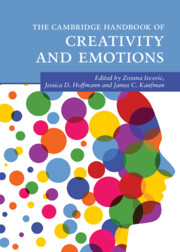Book contents
- The Cambridge Handbook of Creativity and Emotions
- Cambridge Handbooks in Psychology
- The Cambridge Handbook of Creativity and Emotions
- Copyright page
- Dedications
- Contents
- Figures
- Tables
- Contributors
- Acknowledgments
- Creativity and Emotions
- Part I Methods in the Study of Creativity and Emotions
- Part II The Development of Creativity
- Part III Emotions and the Creative Person
- Part IV Emotions and Creative Products
- 17 Emotional Creativity
- 18 Affective Factors in Dark Creativity
- 19 For Emotion’s Sake … The Centrality of Emotions in the Art Experience
- 20 The Affective Benefits of Creative Activities
- 21 Everyday Creativity as a Pathway to Meaning and Well-Being
- 22 Creative Arts Therapies
- 23 Developing Emotion Abilities through Engagement with the Arts
- Part V Emotions and Creativity at School and Work
- Index
- References
17 - Emotional Creativity
Emotional Experience as Creative Product
from Part IV - Emotions and Creative Products
Published online by Cambridge University Press: 16 February 2023
- The Cambridge Handbook of Creativity and Emotions
- Cambridge Handbooks in Psychology
- The Cambridge Handbook of Creativity and Emotions
- Copyright page
- Dedications
- Contents
- Figures
- Tables
- Contributors
- Acknowledgments
- Creativity and Emotions
- Part I Methods in the Study of Creativity and Emotions
- Part II The Development of Creativity
- Part III Emotions and the Creative Person
- Part IV Emotions and Creative Products
- 17 Emotional Creativity
- 18 Affective Factors in Dark Creativity
- 19 For Emotion’s Sake … The Centrality of Emotions in the Art Experience
- 20 The Affective Benefits of Creative Activities
- 21 Everyday Creativity as a Pathway to Meaning and Well-Being
- 22 Creative Arts Therapies
- 23 Developing Emotion Abilities through Engagement with the Arts
- Part V Emotions and Creativity at School and Work
- Index
- References
Summary
The chapter summarizes the conceptual foundations of, and research on, emotional creativity (EC). Emotional creativity is defined as a pattern of cognitive abilities and personality traits related to originality and appropriateness in emotional experience. Emotional creativity is related to personality traits (e.g., openness to experience), positive affect, post-traumatic growth, and engagement in creative leisure activities. In applied settings, emotional creativity is related to innovative performance of employees as well as higher teaching efficacy. Meta-analysis revealed that women showed higher emotional creativity than men. Emotional creativity is also lower in older adulthood compared to younger age. Because the levels of EC are sensitive to the decline of cognitive functions in older adults, their decrease can be considered as one of the indicators of cognitive aging. Recent research in clinical neuropsychology has also revealed that older adults in the early stages of Parkinson’s disease showed decreased emotional creativity compared to healthy older adults. Several directions and research questions for future research are developed.
- Type
- Chapter
- Information
- The Cambridge Handbook of Creativity and Emotions , pp. 321 - 339Publisher: Cambridge University PressPrint publication year: 2023
References
- 2
- Cited by



